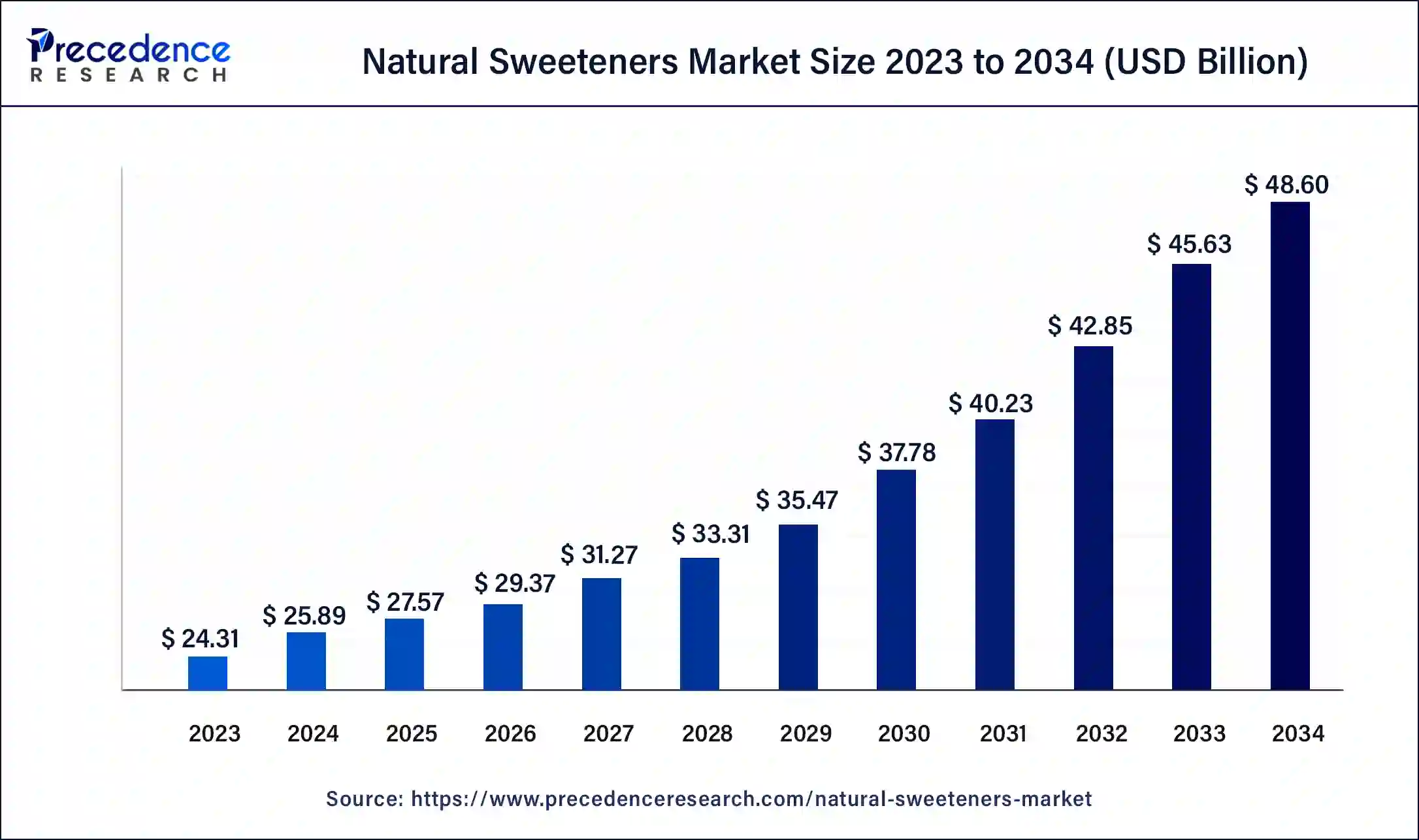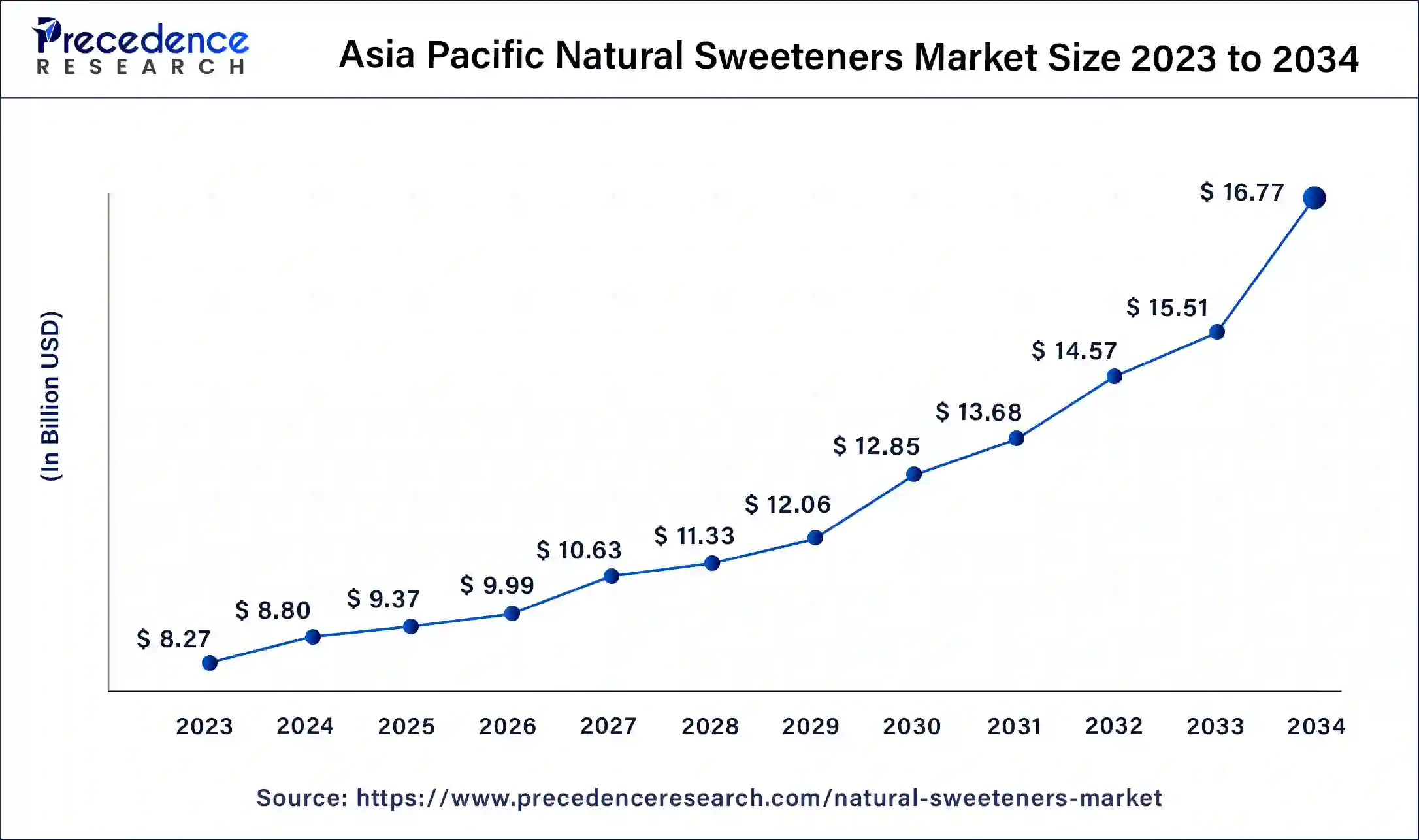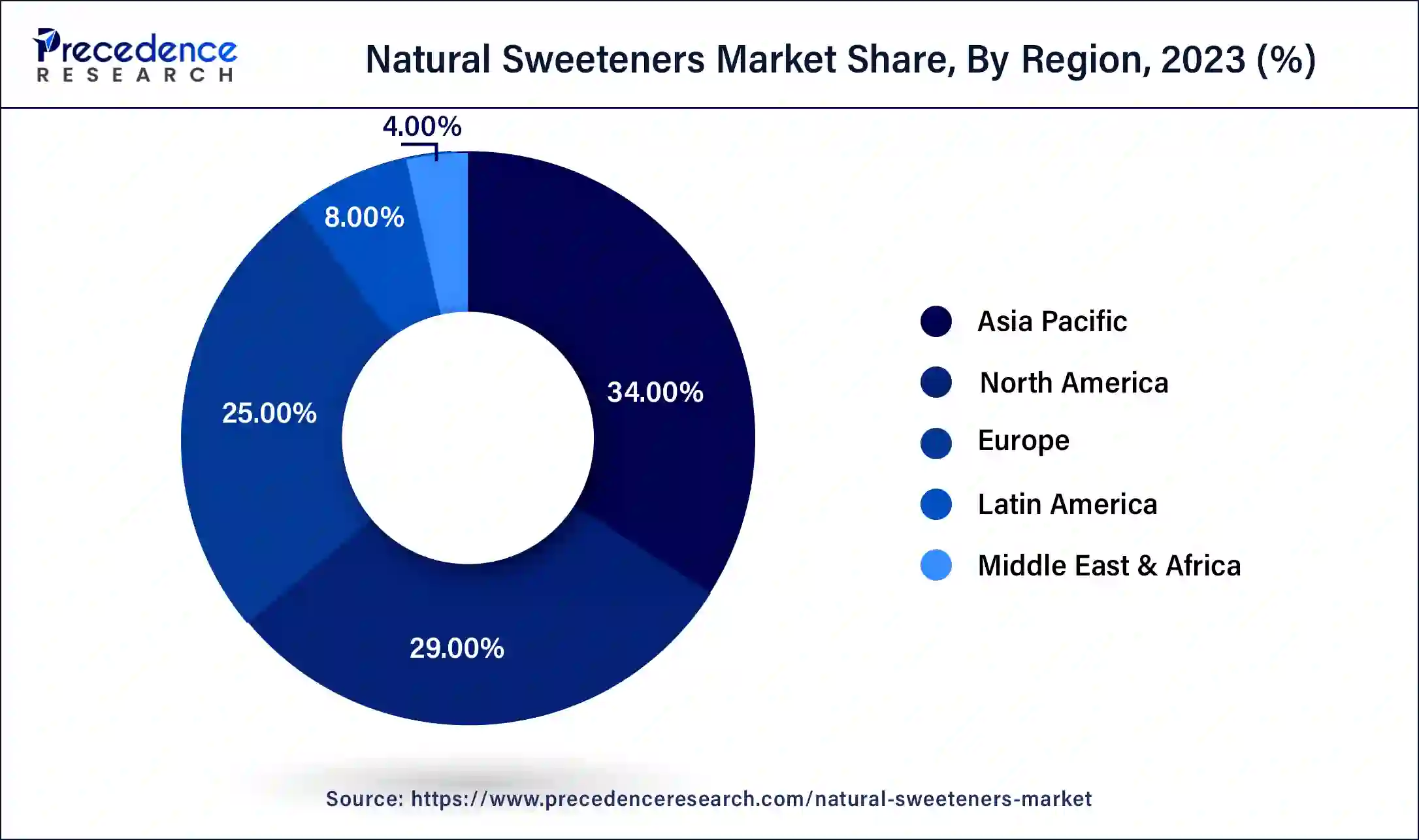List of Contents
Natural Sweeteners Market Size and Forecast 2025 to 2034
The global natural sweeteners market size was valued at USD 25.89 billion in 2024, and is anticipated to reach around USD 48.60 billion by 2034, at a CAGR of 6.50% from 2025 to 2034. Growth in the market is driven by a shift in consumer preferences towards healthier foods. Consumers are also increasingly expressing a desire for natural products that are free from ‘artificial' additives, leading to further growth in the natural sweeteners market.

Natural Sweeteners Market Key Takeaways
- In terms of revenue, the market is valued at USD 27.57 billion in 2025.
- It is projected to reach USD 48.60 billion by 2034.
- The market is expected to grow at a CAGR of 6.50% from 2025 to 2034.
- Asia Pacific dominated the natural sweeteners market with the largest market share of 42% in 2024.
- North America is expected to grow with the fastest CAGR in the market during the forecast period.
- By type, the other segment dominated the market in 2024.
- By type, the stevia segment is expected to grow with the fastest CAGR in the market during the forecast period.
- By application, the beverage segment accounted for the largest share of the market in 2024.
- By application, the bakery segment is set to grow at the fastest rate in the market during the forecast period between 2025 and 2034.
- By end-user, the food & beverage industry dominated the market in 2024.
Asia Pacific Natural Sweeteners Market Size and Growth 2025 to 2034
The Asia Pacific natural sweeteners market size is exhibited at USD 9.37 billion in 2025 and is projected to be worth around USD 16.77 billion by 2034, poised to grow at a CAGR of 6.63% from 2025 to 2034.

Asia Pacific made up the largest share of the natural sweeteners market in 2024. Natural sweeteners such as honey, dates, and molasses have been popular in the region since ancient times and are valued for their nutritional and medicinal properties. This has led to a shift in consumer preferences towards natural sweeteners such as stevia, coconut sugar, and fructose. Several Asian countries are also promoting innovation in natural sweeteners and implementing sugar taxes to reduce sugar consumption rates in nations like Cambodia, China, India, Laos, Malaysia, Sri Lanka, Thailand, and the Philippines. China is trying to combat its high obesity rates by starting initiatives such as Healthy China 2030 to help citizens adopt healthy diets and regular exercise regimens.
- In May 2023, the World Health Organization released guidelines that recommend against using non-sugar sweeteners to control body weight and reduce the risk of noncommunicable diseases in adults or children.
- In 2016, the Chinese government published guidelines advising individuals to consume no more than 50 g of added sugar per day and preferably no more than 25 g. The government has also encouraged the use of natural sweeteners in the processed food sector and encouraged retailers to allocate dedicated shelf space for low-sugar products.

North America is expected to grow with the fastest CAGR in the natural sweeteners market during the forecast period. Consumers in the United States are increasingly demanding low-sugar and sugar-free food and beverage options to combat rising health issues such as diabetes, obesity, and tooth decay. Relatively newer natural sugars such as Allulose were first approved for use in the US over a decade ago by 2023.
- According to the American Heart Association, adults and children in the United States consume 17 teaspoons of added sugar on average daily, which amounts to twice the recommended amount.
Which Natural Sweeteners Are Gaining Popularity in the European Market?
The European natural sweeteners market is expected to witness significant growth over the forecast period. The rising awareness of consumers regarding health benefits and the growing market demand for low-calorie and organic products drive the market growth. Due to rising concerns about the poor health setbacks of sugar, particularly from ultra-processed foods, artificial sweeteners, and sugar use have become highly controlled. The policies will drive food manufacturers to use natural sugar such as stevia, honey, and molasses, driving up market demand. Moreover, clean-label food products with the usage of natural ingredients instead of synthetic additives are preferred by consumers.
How Fast Is the Demand for Natural Sweeteners Growing in MEA?
The MEA is experiencing an active involvement of governments and players in the industry, promoting sugar reduction programs, thus putting natural sweeteners at anadvantage. MEA market has the advantage of culture leaning heavily on using traditional natural sweeteners and an increase in the informative levels of health and wellness trends. The political demand has also indicated that the market of natural sweeteners in the Middle East and Africa is poised to rise due to continuous state backing and creativity in the sugar substitutes industry.
Market Overview
Natural sweeteners are substances derived from plants added to food and beverages to make them taste sweet. These sweeteners contain some type of sugar or a sweet-tasting sugar substitute. Natural sweeteners are classified into two categories: high-potency sweeteners and bulk sweeteners. Some examples of natural sweeteners include honey, dates, stevia, sugar, sugar alcohols, maple syrup, and agave nectar. A global rise in lifestyle diseases such as diabetes is leading consumers to become more health-conscious. Consumers are becoming more aware of natural ingredients, which has caused the demand for naturally derived sweeteners to grow drastically in the past decade.
Sweeteners such as stevia and sugar alcohols are often added to food items and marketed as ‘sugar-free' or ‘diet,' acting as further incentives for growth in the natural sweeteners market. Growth in the market is restricted by the challenges of balancing taste and health benefits and navigating regulatory food and health safety rules across different regions. However, recent product innovations and demand from untapped markets are creating opportunities in the market.
Key factors influencing future market trends
- Product Portfolio growth: The players in the market are already pursuing aggressive moves to develop the natural sweetener product lines to meet the diverse tastes and preferences of the consumers. This involves developing new forms of sweeteners, enhancing the sensory characteristics, and developing inventive mixtures that imbibe a combination of more than one sweetener to have good performance.
- Increasing Demand for Plant-Based Sweeteners: Increasing consumer interest in natural ingredients and plant-based diets has been stimulating demand for plant-sourced sweeteners such as stevia, monk fruit, and agave sweeteners. The orientation of this towards plant-based products contributes to sustainability, and the trend of consumers dissatisfied with the cleaner and more natural representations of food.
How Artificial Intelligence is Transforming the Natural Sweeteners Market
Artificial intelligence is transforming the natural sweeteners market in numerous ways. For the sweetener market, startups such as Shiru are enabling protein marketplaces. These enable businesses to use AI and machine learning to identify and test proteins from high-intensity sweeteners. Platforms such as e-Sweet are being developed for automatic prediction of sweeteners and their corresponding relative sweetness, enabling experimental food scientists to exploit the current machine-learning methods to boost the discovery of more sweeteners with low or zero calorie content.
- In July 2024, Ingredion, a United States-based startup, began using AI modeling to predict sweetness outcomes and better understand consumer relationships with sugar, enabling the creation of customized, cost-effective ingredients that target unmet consumer needs.
Natural Sweeteners Market Growth Factors
- Growing health consciousness among consumers is leading to substantial growth in the natural sweeteners market.
- Widespread awareness about the side effects of artificial sweeteners is propelling growth in the natural sweeteners market.
- The development of varieties of natural sweeteners through biotechnology research is also contributing to growth in the natural sweeteners market.
Market Scope
| Report Coverage | Details |
| Market Size by 2034 | USD 48.60 Billion |
| Market Size in 2025 | USD 27.57 Billion |
| Market Size in 2024 | USD 25.89 Billion |
| Market Growth Rate from 2025 to 2034 | CAGR of 6.50% |
| Largest Market | Asia Pacific |
| Base Year | 2024 |
| Forecast Period | 2025 to 2034 |
| Segments Covered | Type, Application, End-user, and Regions |
| Regions Covered | North America, Europe, Asia-Pacific, Latin America, and Middle East & Africa |
Market Dynamics
Drivers
Growing consumer awareness around healthy eating
In the past decade, there has been a spike in the incidence of lifestyle diseases such as diabetes, pushing consumer awareness around healthy eating. Many consumers are also becoming increasingly aware of the trace nutrients found in natural sweeteners and their benefits. Over half of the consumers are switching to healthy eating, reducing consumption of processed foods and sugar, fat, and salt. Consumer demand for all-natural ingredients is pushing the use of natural sweeteners in the bakery and confectionary industries. This has shifted consumer preferences towards clean-label products, driving growth in the natural sweeteners market.
- The International Diabetes Federation predicts that by 2045, approximately 783 million will be affected by diabetes, accounting for a 46% increase. Individuals affected by diabetes also tend to develop cardiovascular and renal comorbidities.
- According to a 2022 McKinsey & Company survey, the COVID-19 pandemic has had a significant impact on the eating patterns of consumers across age groups and regions. 40% of consumers also report eating fresher, healthier foods.
Increased consumer consciousness around the side effects of artificial sweeteners.
International medical organizations are recommending individuals not to use sugar substitutes in the long run because of their health-related complications. This has caused increasing awareness of the side effects of artificial sweeteners among consumers. Thus driving the natural sweeteners market.
- According to a 2023 survey by Kerry in Asia Pacific, Middle East, and Africa, 98% of all polled respondents had negative taste and health perceptions of artificial sweeteners, with 58% perceiving them to be bad for health and 47% perceiving them to have harmful side effects. These factors are also spurring growth in the natural sweeteners market.
- In May 2023, the World Health Organization released guidelines that recommend against using non-sugar sweeteners to control body weight and reduce the risk of noncommunicable diseases in adults or children.
Restraints
Studies into natural sweeteners are revealing side effects
Some natural sweeteners have been linked to side effects such as increased risk of heart disease, stroke, fatty liver disease, kidney issues, digestive issues, and blood clotting. Studies on agave have shown that high fructose may lead to increased triglycerides and the risk of fatty liver disease. A 2023 study linked erythritol, a sugar alcohol, to a higher risk of heart attack, stroke, and blood clotting. Other sugar alcohols, such as Xylitol, have also been linked to digestive issues, including gas, diarrhea, or general digestive discomfort, especially in children. Popular natural sweetener stevia has also been linked to an increased heart attack and stroke risk. Along with these side effects, some sweeteners are reported to have an unpleasant aftertaste and are expensive to produce. These factors are restricting growth in the natural sweeteners market.
Opportunity
Development of new sweeteners
Advances in biotechnological research have led to the establishment of new production methods, such as plant cell culture or microbial fermentation, to spur commercial-scale production of natural sweeteners. Emerging ingredients such as chicory root inulin and ‘modified' sugar from plant-based sources are the two key innovations in natural sugar-reduced solutions. In the natural sweeteners market, researchers are also looking into the production of natural sugar substitutes in yeast. Several synthetic biology and metabolic engineering strategies, such as increasing the availability of substrates, alleviating the catabolite repression, and optimizing the redox balance, are being utilized in the production of natural sugar substitutes in yeast.
- In 2022, University of Florida researchers discovered eight new sweetener or sweetness-enhancing compounds in 11 citrus cultivars, including UF 914 (a grapefruit hybrid) and EV-2 and OLL-20 (both sweet oranges). 13-51, 18A-4-46, 18A-9-39, 18A-10-38 (Mandarins).
Type Insights
The other types segment dominated the natural sweeteners market in 2024. Honey is a natural product produced by honeybees from the nectar of flowers. Humans have used honey for nearly 5500 years, with most ancient civilizations, including the Greeks, Chinese, and Egyptians, consuming honey for its medicinal properties. Several studies have shown that honey has antioxidant, anti-inflammatory, antibacterial, anti-diabetic, respiratory, gastrointestinal, cardiovascular, and nervous system protective effects. Honey is a popular natural sweetener due to its food safety, taste, solubility, and reasonable cost.
The stevia segment is expected to grow with the fastest CAGR in the natural sweeteners market during the forecast period. Stevia is extracted from the leaves of the Stevia rebaudiana Bertoni (Asteraceae) plant native to South America. However, due to increased demand, it is currently growing in some countries in Europe and Asia. Stevia is popular among diabetic patients due to its non-significant calorie contribution yet sweet taste. Countries like Japan have been using stevia extracts for more than 30 years. Stevia has seen growing popularity over the past four years, with product availability in over 35 countries since 2010.
Application Insights
The beverage segment accounted for the largest share of the natural sweeteners market in 2024. The beverage industry, in particular, has adopted natural sweeteners. Tate & Lyle, ED&F Man/Unavoo Food Technologies Ltd, and Cargill have all developed natural high-intensity sweeteners for use in beverages.
The bakery segment is set to grow at the fastest rate in the natural sweeteners market during the forecast period between 2024 and 2033. The baking industry has historically used natural sweeteners such as honey and maple syrup for their unique browning, flavor, and moisture characteristics. Other natural sweeteners such as agave nectar, coconut sugar, date sugar, and jaggery sugar are also being widely adopted in the baking industry to achieve desired product qualities and a clean label.
End-User Insights
The food & beverage industry dominated the natural sweeteners market in 2024. Sugars are widely used to sweeten foods and beverages. However, with growing health concerns, natural sweeteners are being used to replace sugar in the industry. Stevia and monk fruit are also being more commonly used to replace sugar in the food industry today. Newer ingredients such as chicory root inulin and ‘modified' sugar from plant-based sources are being used in the food and beverage industry, with companies such as Cargill, CoSucra, and Sensus adopting them.
Natural Sweeteners Markets Companies
- Archer-Daniels-Midland Company
- Cargill Incorporated
- FoodChem International Corporation
- GLG Life Tech Corporation
- Herboveda India
- Ingredion Incorporated
- Morita Kagaku Kogyo Co. Ltd
- PureCircle Ltd.
- Pyure Brands LLC
- Roquette Frères
- Sweetly Stevia USA
- Tate & Lyle PLC
Recent Developments
- In July 2024, Canada-based NutraEx Food, Inc launched Bi-Sugar. The company created Bi-Sugar through dry-embedding, a technology that bonds L-arabinose to regular sugar and another natural sweetener. The new sweetener may have applications in beverages, bakery, confectionery, and dairy.
- In April 2024, MycoTechnology, Inc. made progress in commercializing a new sweet protein sourced from honey truffles. Since the protein's announcement in 2023, the company has transitioned from production on the laboratory scale to 3000-liter tanks, boosting the product's production efficiency and cost optimization.
- In January 2024, Cargill and DSM-firmenich's joint venture Avansya announced that EverSweet, a stevia sweetener, received a positive safety opinion from the UK Food Standards Agency and the European Food Safety Authority. This brings the sweetener closer to commercial availability in the United Kingdom and the European Union.
Segments Covered in the Report
By Type
- Stevia
- Sorbitol
- Xylitol
- Mannitol
- Erythritol
- Sweet Proteins
- Other Types
By Application
- Bakery Products
- Confectioneries & Gums
- Spreads
- Beverages
- Dairy Products
- Frozen Desserts
- Tabletop Sweeteners
- Pharmaceutical Products
- Other Applications
By End-user
- Food & Beverages
- Pharmaceutical
- Direct Sales
- Other End-Use Sectors
By Geography
- North America
- Asia Pacific
- Europe
- Latin America
- Middle East & Africa
For inquiries regarding discounts, bulk purchases, or customization requests, please contact us at sales@precedenceresearch.com
Frequently Asked Questions
Ask For Sample
No cookie-cutter, only authentic analysis – take the 1st step to become a Precedence Research client